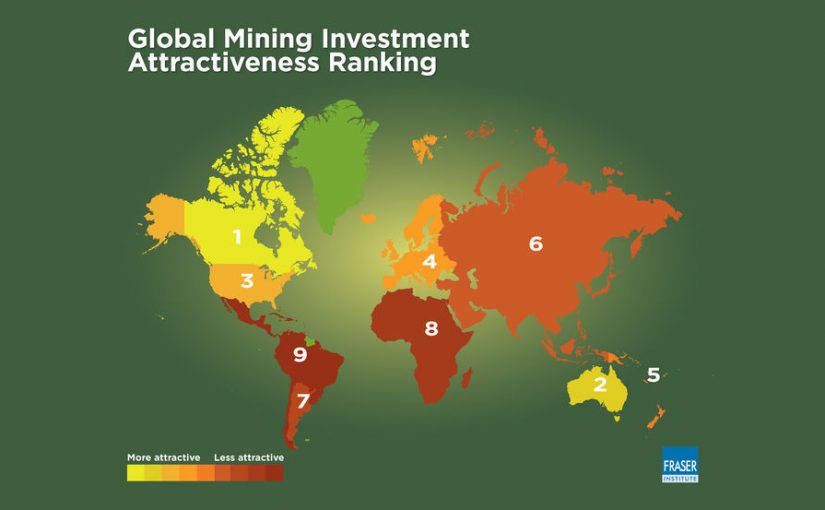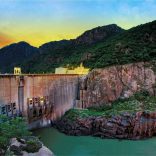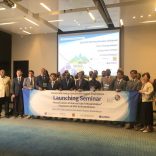Zimbabwe and Zambia may reduce water deficit in Mozambique's Cahora Bassa - Noticias
Mozambique ranked among bottom ten in Global Mining Investment Attractiveness Index

Fraser Institute Annual Survey of Mining Companies 2017
Finland has ousted Saskatchewan as the top international jurisdiction for mining investment, Canada’s Fraser Institute announced on Thursday.
Canada’s leading independent think-tank, the Fraser Institute, administers its Annual Survey of Mining Companies and ranks jurisdictions around the world based on a combination of their geological attractiveness for minerals and metals and their policy attractiveness.
“Rich mineral reserves, competitive taxes, efficient permitting procedures and certainty around environmental regulations will still attract significant investment – even with slumping commodity prices,” said senior director of energy and natural resource studies Kenneth Green.
The 2016 Investment Attractiveness Index report showed that Canada had both the best (Saskatchewan) and second-best (Manitoba) mining jurisdictions in the world, but this changed in 2017, with Finland jumping from fifth position in the 2016 survey, to the top of the most recent list, while Saskatchewan dropped to second place, followed by Nevada – up from fourth place in 2016.
The Republic of Ireland ranked fourth this year, and Western Australia dropped from third in 2016, to fifth in 2017. Rounding out the top ten were Quebec, Ontario, Chile, Arizona, and Alaska, the institute said.
Guatemala ranked as the least attractive jurisdiction in the world for investment on the same index, replacing the Argentinian province of Jujuy as the least attractive jurisdiction in the world. Also in the bottom ten were Kenya, Mendoza, Chubut, Mozambique, Bolivia, Venezuela, Romania, China and Nicaragua.
The Fraser Institute also derives its Policy Perception Index (PPI) from the survey, which acts like a report card for governments on the attractiveness of their mining policies.
For the fifth year in a row, the Republic of Ireland had the highest PPI score of 100. Ireland was followed by Finland in second, which moved up from fourth position in the previous year. Along with Ireland and Finland the top ten ranked jurisdictions are Saskatchewan, Sweden, Nevada, Northern Ireland, Michigan, Wyoming, Quebec and Newfoundland and Labrador.
At the bottom end of the PPI were Venezuela, Chubut, Zimbabwe, Guatemala, the Democratic Republic of Congo (DRC), China, Philippines, Indonesia, Bolivia and Ecuador. Venezuela, Chubut, Zimbabwe, Philippines, Indonesia and Ecuador were all in the bottom ten jurisdictions last year, the institute noted.

The Investment Attractiveness Index takes both mineral and policy perception into consideration
The Investment Attractiveness Index takes both mineral and policy perception into consideration
An overall Investment Attractiveness Index is constructed by combining the Best Practices Mineral Potential index, which rates regions based on their geologic attractiveness, and the Policy Perception Index, a composite index that measures the effects of government policy on attitudes toward exploration investment. While it is useful to measure the attractiveness of a jurisdiction based on policy factors such as onerous regulations, taxation levels, the quality of infrastructure, and the other policy related questions that respondents answered, the Policy Perception Index alone does not recognise the fact that investment decisions are often sizably based on the pure mineral potential of a jurisdiction. Indeed, as discussed below, respondents consistently indicate that approximately 40 percent of their investment decision is determined by policy factors.
The top
The top jurisdiction in the world for investment based on the Investment Attractiveness Index is Finland, which moved up from 5th place in 2016. Saskatchewan experienced a slight drop in its score in 2017 so dropped into second place after ranking first in the previous year. Nevada moved up from 4th in 2016 to 3rd in 2017. The Republic of Ireland ranked 4th this year, and Western Australia dropped from 3rd in 2016 to 5th in 2017. Rounding out the top 10 are Quebec, Ontario, Chile, Arizona, and Alaska.
The bottom
When considering both policy and mineral potential in the Investment Attractiveness Index, Guatemala ranks as the least attractive jurisdiction in the world for investment. This year, Guatemala replaced the Argentinian province of Jujuy as the least attractive jurisdiction in the world. Also in the bottom 10 (beginning with the worst) are Kenya, Mendoza, Chubut, Mozambique, Bolivia, Venezuela, Romania, China, and Nicaragua.
Policy Perception Index: A “report card” to governments on the attractiveness of their mining policies
While geologic and economic considerations are important factors in mineral exploration, a region’s policy climate is also an important investment consideration. The Policy Perception Index (PPI), is a composite index that measures the overall policy attractiveness of the 91 jurisdictions in the survey. The index is composed of survey responses to policy factors that affect investment decisions. Policy factors examined include uncertainty concerning the administration of current regulations, environmental regulations, regulatory duplication, the legal system and taxation regime, uncertainty concerning protected areas and disputed land claims, infrastructure, socioeconomic and community development conditions, trade barriers, political stability, labour regulations, quality of the geological database, security, and labour and skills availability.
The top
For the fifth year in a row, the Republic of Ireland had the highest PPI score of 100. Ireland was followed by Finland in second, which moved up from 4th in the previous year. Along with Ireland and Finland the top 10 ranked jurisdictions are Saskatchewan, Sweden, Nevada, Northern Ireland, Michigan, Wyoming, Quebec, and Newfoundland and Labrador.
The bottom
The 10 least attractive jurisdictions for investment based on the PPI rankings are (starting with the worst) Venezuela, Chubut, Zimbabwe, Guatemala, Democratic Republic of Congo (DRC), China, Philippines, Indonesia, Bolivia, and Ecuador. Venezuela, Chubut, Zimbabwe, Philippines, Indonesia, and Ecuador were all in the bottom 10 jurisdictions last year.
Global decline
The institute noted that investment attractiveness fell slightly around the world.
In Australia, every jurisdiction received lower scores on policy this year, indicating increasingly unattractive government regulations across the country. Western Australia ranked fifth overall, followed by Queensland (12) and South Australia (14).
As a whole, Australia – which ranked as the most attractive region overall last year – has fallen to second place this year after Canada. The US is the third most attractive region overall, followed by Europe.
In South America, Chile (8) has jumped back into the top ten, after falling to thirty-ninth place last year. Peru, which ranked twenty-eighth last year, also rose to nineteenth in this year’s survey. Argentina is also much more attractive for mining investment this year, with the country’s overall score increasing by more than 50%, according to the institute.
In Africa, the median score on the PPI showed a decline this year. This was also the case for the region’s average investment attractiveness score. In terms of overall investment attractiveness, as a region, Africa ranks as the second least attractive jurisdiction for investment.
Two African countries – Zimbabwe (89) and the DRC (87) – ranked in the bottom ten of the survey rankings this year based on policy. Zimbabwe was also among the bottom ten in the previous five years. Kenya and Mozambique were the only two African jurisdictions in the global bottom ten based on their overall investment attractiveness.
According to the Fraser Institute, Botswana was again the highest-ranked jurisdiction in Africa on policy factors, ranking twenty-first in 2017, after ranking twelfth in 2016. Botswana’s decline in its PPI score this year reflected increased concerns over uncertainty concerning protected areas, political stability, and infrastructure. Namibia was the second most attractive jurisdiction when only policies were considered, ranking thirty-ninth this year.
Africa’s most industrialised economy, South Africa, moved up to the forty-eighth position for investments attractiveness, from seventy-fourth in the 2016 survey. On the PPI, the country ranked eighty-first out of 91, compared with eighty-fourth position out of 104 in the 2016 survey. Respondents cited perceived government corruption and incapacity as significant drawbacks.
“Capital is fluid and one jurisdiction’s loss can be another’s gain because mining investors will flock to jurisdictions that have attractive policies. Sound regulatory regimes are an absolute must for policymakers who want to attract increasingly precious commodity investments,” Green said.
This year, the institute received a total of 360 responses from mining executives for the survey, providing sufficient data to evaluate 91 jurisdictions, the lowest number since 2013, since the number of jurisdictions that can be included in the study tends to wax and wane owing to the cyclical nature of the mining industry, the institute advised.
About the Survey
The survey is designed to capture the opinions of managers and executives about the level of investment barriers in jurisdictions with which their companies are familiar.
The survey was circulated electronically to approximately 2,700 individuals between Aug. 22 and Nov. 10, 2017.
Respondents were asked to indicate how each of 15 policy factors influenced company decisions to invest in various jurisdictions.
Those 15 policy factors are:
– uncertainty concerning the administration, interpretation, or enforcement of existing regulations, uncertainty concerning environmental regulations (stability of regulations, consistency and timeliness of regulatory process, regulations not based on science);
– regulatory duplication and inconsistencies (includes federal/provincial, federal/state, inter-departmental overlap, etc.);
– legal system (legal processes that are fair, transparent, non-corrupt, timely, efficiently administered, etc.), taxation regime (includes personal, corporate, payroll, capital, and other taxes, and complexity of tax compliance);
– uncertainty concerning disputed land claims; uncertainty concerning what areas will be protected as wilderness, parks, or archeological sites, etc.;
– infrastructure (includes access to roads, power availability, etc.); socioeconomic agreements/community development conditions (includes local purchasing or processing requirements, or supplying social infrastructure such as schools or hospitals, etc.);
– trade barriers (tariff and non-tariff barriers, restrictions on profit repatriation, currency restrictions, etc.);
– political stability, labor regulations/employment agreements and labor militancy/work disruptions; quality of the geological database (includes quality and scale of maps, ease of access to information, etc.);
level of security (includes physical security due to the threat of attack by terrorists, criminals, guerrilla groups, etc.); and
– availability of labour, skills.
“In this year’s survey there was increased worry about duplication and inconsistency, and that’s fairly easy to address,” Green said. “The government can do regulatory streamlining, transparency. Taxation was a worry, and infrastructure was a worry.”
British Columbia, at 20, and Alberta, at 49, both continue to receive low marks from investors for regulatory uncertainty and concerns regarding disputed land claims.
Nationally, based on the combined rankings of all provinces and territories, Canada is the world’s most attractive region for investment, beating out Australia for the top spot.
“Capital is fluid and one province’s loss can be another province’s gain because mining investors will flock to jurisdictions that have attractive policies,” Green said.
“Sound regulatory regimes are an absolute must for policymakers who want to attract increasingly precious commodity investments.”
Read the full report HERE












Leave a Reply
Be the First to Comment!
You must be logged in to post a comment.
You must be logged in to post a comment.